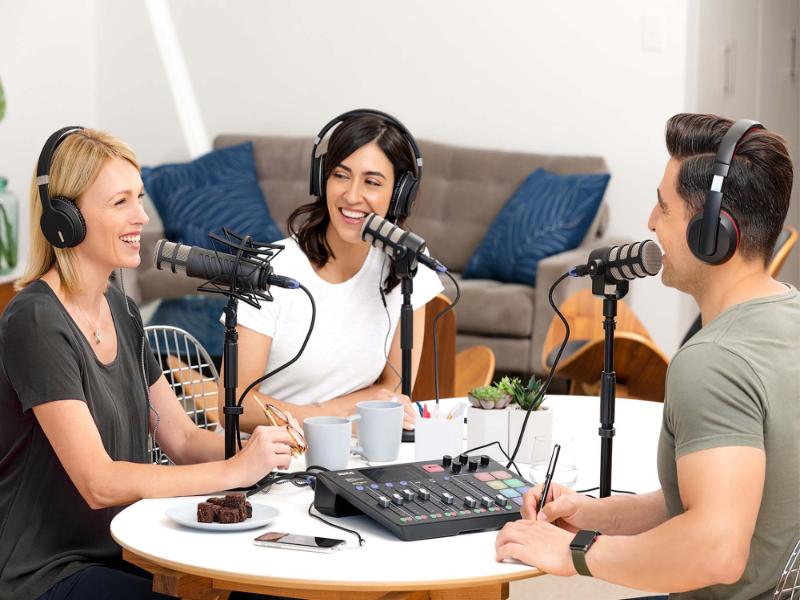Essential Developer’s Guide to Podcasting
Embark on a developer’s journey into podcasting with a comprehensive guide to podcasting that unveils the essentials, from technical intricacies to storytelling finesse, empowering you to launch and sustain your podcasting venture with confidence.”
If you’re looking to join the millions of people worldwide who have discovered the wonders of podcasting, this guide is perfect for you.
As a developer, you already have a remarkable set of technical skills that would be beneficial in the world of podcasting. You can effortlessly switch from code to content creation by following our podcasting guide tailored for developers.
Buzzsprout Review (Best Podcast Host 2024)
In this guide, we will equip you with all the podcasting strategies you need to create engaging content, build a listener base, and achieve success.
Take advantage of the podcasting tips offered in each section of this guide and start your podcasting journey today.
Guide to Podcasting for Beginners
So, you want to start podcasting but don’t know where to begin? Don’t worry – we’ve got you covered. In this section, we’ll guide you through the essential steps to get your podcast up and running.
Choosing a Topic
The first step to starting a podcast is selecting a topic that you’re passionate about. Whether it’s cooking, finance, or true crime, your podcast must be something that you enjoy talking about.
To ensure your podcast is unique, research the competition and identify gaps in the market that you can fill.
Developing Your Concept
Once you’ve chosen your topic, it’s time to develop your podcast concept. Consider the format – will it be an interview-style show or a solo discussion?
Identify the theme and audience, and think about how to make your podcast stand out. By developing a concept, you’ll make your podcast more engaging and easier to market.
Targeting Your Audience
Knowing your audience is crucial to building your podcast’s success. Who are they, and what are their interests?
Research your target audience demographics and tailor your content to their interests. The better your content resonates, the more likely you’ll grow your listener base, and in turn, your success.
Selecting the Right Podcasting Equipment and Software
To create top-quality audio content, you’ll need the right equipment and software. Look for a microphone with high-quality sound capture and noise reduction.
Consider the environment in which you’ll be recording, and acquire the appropriate tools to eliminate background noise. There’s no right or wrong software – find what suits your needs and budget!
Using these strategies, you’ll be on your way to creating a successful podcast. However, starting a podcast is just the beginning. In our next section, we’ll discuss how to plan episodes that engage and inspire your listeners.
Planning Your Podcast Episodes
Creating engaging content is essential for a successful podcast. Planning your podcast episodes can help with keeping your audience gripped from start to finish. To help you improve the quality of your podcast, we have outlined essential tips and strategies below:
Structure Your Episodes
Start by structuring your podcast episodes, keeping in mind that your audience needs a logical flow of ideas. Ensure your podcast has a uniform format that includes an introduction, main points, and a conclusion.
Develop a Theme
Targeting niche areas can give your podcast a clear direction. Focus on developing themes that your audience would be interested in. The themes should be unique and engaging, providing a consistent touch to your episodes.
Script and Format Your Episodes
Scripting and formatting your episodes can help with providing clarity to your podcast. Follow your script and try to keep tangents to a minimum. Structure your episodes in short and precise sections that blend easily.
Implementing these tips in your podcast can help with creating engaging and informative content. Keep your audience at the forefront and ensure to stay on-topic while injecting your personality into your episodes.
Unleash Your Creativity: The Ultimate Top 10 Apps for Content Creators
Recording and Editing Your Podcast
Recording and editing your audio is critical to ensuring a high-quality podcast. Our guide will take you through the process of selecting the right podcasting equipment, setting up your recording space, and editing your podcast episodes.
Selecting the Right Podcasting Equipment
To achieve high-quality sound, it’s essential to invest in the right podcasting equipment. Here are some tips:
- Choose a high-quality microphone to capture clear audio.
- Select a recording device that meets your needs and budget. Consider using a digital recorder, audio interface or mixer, or your computer.
- Avoid recording in noisy environments. Use sound-absorbing materials in your recording space to improve sound quality and reduce background noise.
Setting Up Your Recording Space
Your recording space will also impact the sound quality of your podcast. Here are some tips:
- Choose a quiet, soundproof room for recording.
- Consider hanging sound-absorbing materials, such as blankets or acoustic foam if you don’t have a soundproof room.
- Test and adjust your recording space to find the best sound quality. Record a test episode with different settings to determine which works best.
Editing Your Podcast Episodes
Editing your podcast episodes can help improve the overall quality and engagement of your podcast. Here are some tips:
- Choose the right podcasting software to edit your audio. There are various free and paid options available.
- Remove any unwanted background noise or filler words, such as “um” and “ah.”
- Normalize your audio levels to ensure consistent sound volume throughout your episode.
- Add music and sound effects to enhance the listener’s experience.
By following these podcasting tips, you’ll be able to record and edit your podcast episodes like a pro. Stay tuned for the next section, where we will explore selecting the right podcasting platform.
Choosing a Podcasting Platform
If you’re looking to reach your target audience, choosing the right podcasting platform is crucial. There are several podcasting software options available, each with unique features that can help your podcast stand out.
When selecting a podcasting platform, consider the following factors:
- The platform’s audience: Look for a platform that caters to your target audience. You want a platform where your listeners are already active and engaging.
- Features: Consider the platform’s features, such as analytics tools and the ability to schedule and publish episodes in advance.
- Technical requirements: Check the technical requirements for each platform, including compatible file formats and size restrictions.
- Cost: Determine the cost of using each platform, including any subscription fees or revenue-sharing agreements.
Once you’ve chosen a podcasting platform, it’s essential to optimize your podcast for the platform. Pay close attention to the platform’s formatting requirements, such as cover art dimensions and episode descriptions. This step ensures that your podcast stands out and draws in listeners.
Maximizing Your Reach
Now that you’ve chosen a platform, it’s time to start reaching out to your target audience. To do this, engage with other podcasters in your niche and collaborate on cross-promotion of each other’s podcasts.
Additionally, promote your podcast on your social media channels and encourage your listeners to share your episodes.
As your podcast gains traction, keep track of your performance metrics. Analytics tools can help you determine which topics and formats are resonating with your audience and which ones aren’t.
This knowledge can help you make data-driven decisions that can propel your podcast to even greater heights of success.
Building a Strong Listener Base
Now that you have a podcast up and running, it’s important to build a listener base to achieve success. Here are some effective podcasting strategies:
- Promote your podcast on social media: Social media platforms like Twitter, Facebook, and Instagram can help promote your podcast and reach a wider audience. Share behind-the-scenes footage, teasers, and intriguing snippets of your episodes to capture your followers’ attention.
- Engage with your audience: Responding to feedback and comments on your podcast can deepen your connection with your listeners and keep them coming back. Make sure to reply timely and with authenticity.
- Collaborate with other podcasters: Collaborations and cross-promotions with other podcasters can help increase your exposure, share your audience, and attract new listeners. Reach out to podcasters in your niche, as well as popular hosts, to create partnerships and grow your audience.
- Effective marketing strategies: Utilize all sorts of marketing channels to promote your podcast. These can include email marketing, search engine optimization, or paid advertising. A well-thought-out marketing campaign can boost your visibility and help you build an effective listener base.
With these podcasting tips, you’re now equipped to build a strong listener base. Engagement with your audience, promotions, collaborations, and marketing efforts are all key to achieving success and growing your audience.
Implement these strategies, remain consistent in your efforts, and track your metrics to analyze your performance and determine which strategies are working for you best.
Monetizing Your Podcast
Congratulations! You’ve produced a podcast, and now you’re ready to monetize it. Here are some podcasting strategies to turn your podcast into a profitable venture:
Sponsorship Opportunities
One of the most common ways to monetize your podcast is through sponsorship opportunities. You can approach potential sponsors directly or use a platform that connects you with brands looking to advertise on podcasts.
When selecting sponsors, it’s essential to find brands that align with your podcast’s values and content.
Affiliate Marketing
Affiliate marketing involves promoting other brands’ products or services on your podcast. You’ll earn a commission for every sale made through your promotional efforts.
Make sure to promote products or services that are relevant to your audience to increase the likelihood of making a sale.
Merchandise Sales
You can also monetize your podcast through merchandise sales. You can create and sell t-shirts, mugs, or other merchandise related to your podcast. Your listeners can show their loyalty and support for your podcast by purchasing your merchandise.
Crowdfunding
Finally, crowdfunding can be a successful way to generate revenue for your podcast. Platforms such as Kickstarter and Patreon allow podcasters to receive donations or investments from fans.
You can offer exclusive content or other perks to your supporters to incentivize them to contribute.
By exploring these monetization strategies, you can turn your successful podcast into a profitable venture. So, what are you waiting for? Start monetizing your podcast today!
Analytics and Measuring Success
Measuring your podcast’s success is critical to making informed decisions. With a range of analytics tools available, you can track key metrics such as downloads, listener demographics, and engagement rates.
By understanding your audience’s behavior, you can make data-driven decisions to improve your podcast’s performance and grow your listener base.
Podcast Analytics Tools to Use
Google Analytics is a popular tool for tracking website analytics, but did you know it can also be used for podcast analytics?
25+ Best Podcasting Tools (Launch and Grow)
By implementing Google Analytics on your podcast website, you can track website traffic, episode downloads, and page views, among other metrics. Other great podcast analytics tools include:
- Blubrry: Provides comprehensive podcast analytics, including engagement rates, subscribers, and demographics.
- Podtrac: Measures audience size, demographics, and listening habits, and offers ad targeting to grow podcast revenue.
- Chartable: Tracks podcast growth, listener demographics, and engagement, and provides real-time data for immediate action.
Key Metrics to Monitor
When tracking your podcast’s performance, there are several key metrics to monitor:
| Metric | Description |
|---|---|
| Downloads | The number of times an episode has been downloaded. |
| Unique Listeners | The number of unique individuals who have listened to an episode. |
| Engagement Rate | The percentage of listeners who finished an episode. |
| Listener Demographics | The age, gender, and location of your listeners. |
By tracking these metrics, you can optimize your podcast to meet your listeners’ needs, increase engagement rates, and grow your listener base.
Use podcast analytics tools and metrics to gain insights into your audience’s behavior and preferences, and make data-driven improvements to your podcast for long-term success.
Conclusion
Congratulations on completing this comprehensive guide to podcasting! By following the strategies and tips outlined in this guide, you now have the knowledge and skills to create engaging content and grow your listener base.
Remember that podcasting is a continuous learning process, and there are always opportunities to improve and refine your skills.
Start your podcasting journey today and engage with your audience through captivating audio content. Utilize the planning techniques, recording and editing tips, and marketing strategies covered in this guide to propel your podcast to success.
Thank you for reading, and we wish you all the best in your podcasting endeavors!







